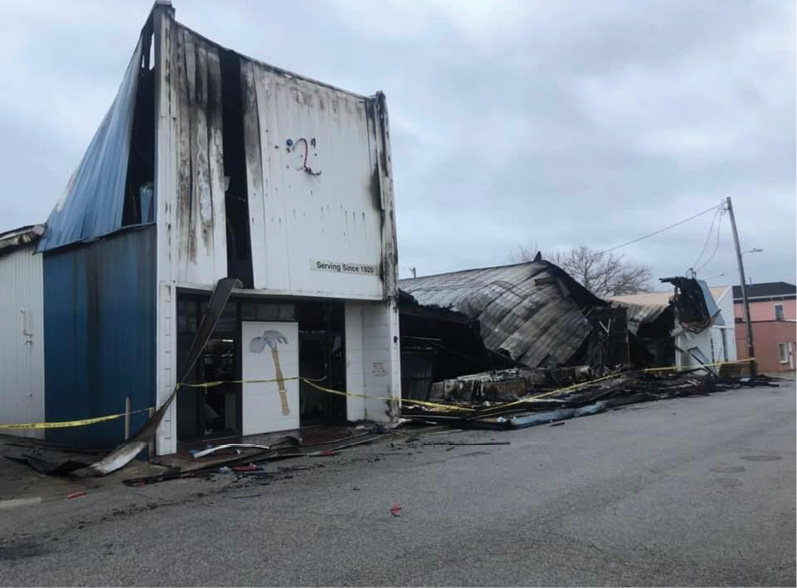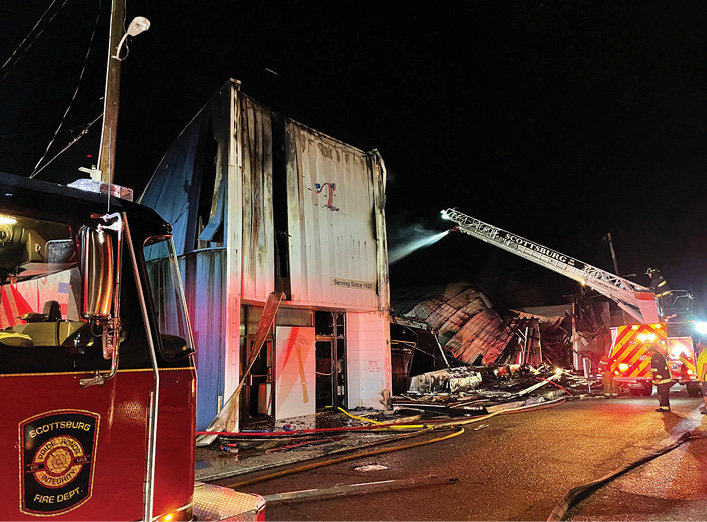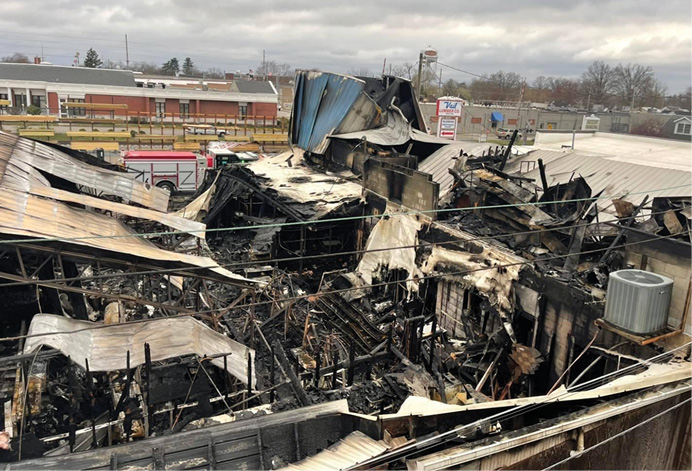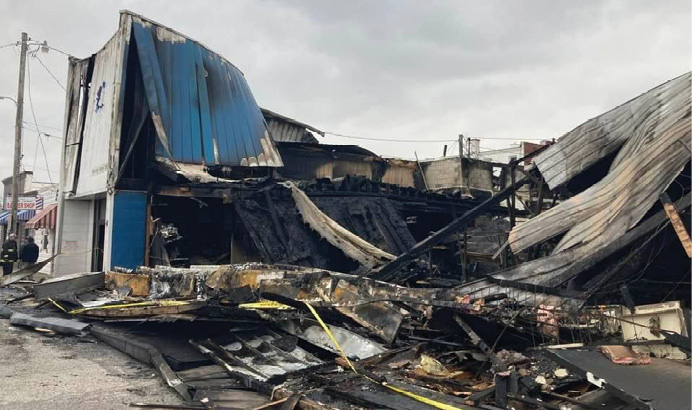By Eric Jones
The night went from bad to worse in a hurry, but no one in the Scottsburg (IN) Fire Department was expecting the challenges we would soon face. I was enjoying a night off shift watching an evening of little league baseball as the clouds became darker and the winds became stronger. Soon the conversations in the stands became less about the game and more about the incoming storm predicted for later that night. Shortly before the end of the game, our department was dispatched to assist in a large woods fire with multiple other county fire departments.
As the night went on, the storm became more severe. It rained off and on, and the wind was approximately 35 miles per hour (mph) with gusts in the upper 50-mph range and lightning reported everywhere. The radio chatter was nonstop, as down power lines and trees were reported among the entire county. Then it happened.

1. The street side post-fire. (Photo by author.)

2. Truck 1 extinguishes the collapsed roof. (Photo by Scott Richie.)
At approximately 10:27 p.m., the alert tone rang and the dispatcher stated, “Scottsburg Fire Department: Respond to Vail’s True Value Lumber Company for a structure fire with a report of visible flames.” I knew this was going to be “the big one,” the one we all dreaded. Since several of the other firefighters were still assisting in the woods fire approximately 15 minutes away, it was time to go to battle. In every firehouse across the country, there is a conversation about the fires in their jurisdiction they hope will never happen; Vail’s was it for our department.
Vail’s True Value Lumber Company had been in business since 1920 and had been a historic business in the community. The structure was a mix of wood frame, metal, and masonry, which had been added onto many times over the years. The structure was full of common building materials, paints, and varnishes including a large indoor lumber storage area. The business was located on the rear side of the town square and surrounded by other businesses on three sides—separated only by an alley. The small, narrow road on the storefront sat between the building and the railroad track, so space was limited—even on a good day.
To add to the chaos of the storm, the woods fire, and the limited staffing available, I was stopped by a train while en route—the same train that separated me from the structure. Although this was a burden, it turned out to be a blessing in disguise, as it gave me a moment to clearly think about what resources would be needed. I requested three fire departments to assist in the fire, two of which were bringing aerial apparatus. Once the train cleared, it was obvious this was going to be a difficult fire and we were going to be here awhile.
I arrived on scene and was met with wind gusts that would almost knock you backward and the scent of an impending rainstorm. I assumed command and stated, “Car 4 on scene. Advised confirmed working commercial structure with visible fire from the roof. Please contact city electric, as a powerline was arcing on the roof from an alley utility pole. Contact Louisville & Indiana Railroad in regard to fire.” After a quick size-up down the alleys to further investigate, I was surprised to find Engine 1 from Station 1 and Engine 2 from Station 2 at the storefront. The looks on everyone’s faces told the story: We all knew this was going to be tough, but we were ready to go to work. In my nearly 18 years of experience, I have never witnessed an operation set up so quickly.

3. Master streams extinguish visible fire from the roof. (Photo by Scott Richie.)

4. An aerial view of the collapsed structure. (Photo courtesy of the Indiana State Fire Marshal’s Office.)

5. Multiple master streams extinguish visible fire from the roof. (Photo by Scott Richie.)
Engine 2 set up at the A/D corner and quickly established a water supply with the assistance of EMS. Members engaged the deck gun and deployed two 2½-inch preconnects, one for the alley and one for the lumber warehouse, which had become nearly fully involved. Engine 1 positioned on the A/B corner and established a water supply, engaged the deck gun, and deployed two 2½-inch preconnects, one for the alley and the other for the storefront. This all took place with minimal communication; everyone knew what they were supposed to do as if we had trained on it 100 times before.
At this point, the fire and smoke were being pushed to the northeast by the increasing wind gusts. One challenge we faced was deciding where to position the aerial, since both engines positioned on the narrow road in front of the store and the remainder of the building was surrounded by other structures. Truck 1 positioned on the roadway on the other side of the railroad tracks. This presented an additional challenge, as the aerial stream was not effectively hitting the target because of the extremely high wind gusts.
At this time, additional fire departments arrived, and it was a relief to have assistance and personnel. Approximately three fire departments were positioned on the square front side to provide fire suppression efforts from the east and to protect the square businesses and apartments as other fire departments assisted us on the store side. Fire personnel assisted in notifying and evacuating residents from the second-floor apartment located directly behind the lumberyard.

6. The street-side collapse post-fire. (Photo by author.)

7. Truck 1 extinguishes visible fire from the roof. (Photo by Scott Richie.)
At one point, I saw a woman standing at the front bumper of Engine 2 with a look of sadness and fear on her face. I asked the county emergency management agency director, who was nearby, to ask the woman to back up into the cold zone area, as she was much closer than any civilian should be.
Approximately 30 minutes into the operation, multiple fire departments and firefighters were on scene working the fire from all angles. The wind and rain were brutal, yet the firefighters stood strong and continued to work. Hoselines stretched all over the street and down the alleyways. The streets had begun to flood because the hose and tools in the streets were blocking the drainage. At this time, I passed command to Chief James Richey, who arrived from the woods fire and had been briefed on the current incident status.
Over the course of the next several hours, an additional aerial arrived on scene to assist with aerial fire suppression efforts. Fire personnel had fought long and hard to control the fire in the interior warehouse area and had begun making the push to the store area. Firefighters advanced into the interior of the store area with caution, as the structure had sustained heavy fire and water damage. During this time, the A side (street side) began to show immediate signs of collapse, and the city street department used heavy equipment to remove the street side wall.
Once the A side partially collapsed and had been removed, we began overhaul. Fire personnel cautiously extinguished hot spots; some were very stubborn, as the building had many layers added over the years. The street on the storefront side had approximately 100 gallons of paint and varnish spilling, which saturated the hose and equipment.
The rain finally stopped and daylight broke. It was bitter cold, and we were all soaking wet from the hours battling the incident. The assisting fire departments were released one at a time. At this point, only our department remained on scene.
As companies began to break down equipment and prepared to return to the station, I saw the same woman I had seen earlier. She appeared to be cold and damp. I approached her and asked if she needed anything. She advised that she had been at the incident the entire duration as she couldn’t leave. She immediately applauded the fire department for its efforts in saving the town square, as it didn’t appear any other business received any fire or structural damage. She said the business had been in her family for years, and she had many childhood memories of the building. She was devastated that it was now gone.
We reported back to the station for the long task of putting the apparatus back in service. Everyone was exhausted both mentally and physically, beyond the point of realizing what good we had done for the community. Once we had a chance to rest, we were able to reflect on the incident. For a large commercial lumberyard and structure to be surrounded on three of the four sides with as tall or taller structures with nothing more than minor smoke and water damage beyond the initial fire, this was the best possible outcome. This could not have happened without all the support and assistance we received from all our neighboring fire departments.
This incident is one most who were there will never forget for their entire career, maybe a lifetime. The night was long and cold, and the weather was unbearable for the majority of the incident. We were tasked with extremely difficult conditions on arrival, but the outcome was as good as anyone could have hoped. The remainder of the structure was later removed and cleared, and the lot still sits empty today. It’s a piece of our community that will physically be gone forever but will remain a memory for many.
Eric Jones is an 18-year veteran of the Scottsburg (IN) Fire Department and a captain and training officer. He is a member of the Indiana Fire Instructors Association, International Society of Fire Service Instructors, and International Association of Arson Investigators and is a live fire safety officer for FDIC International. He is the founder and lead instructor for Fire First Culture & Training.

